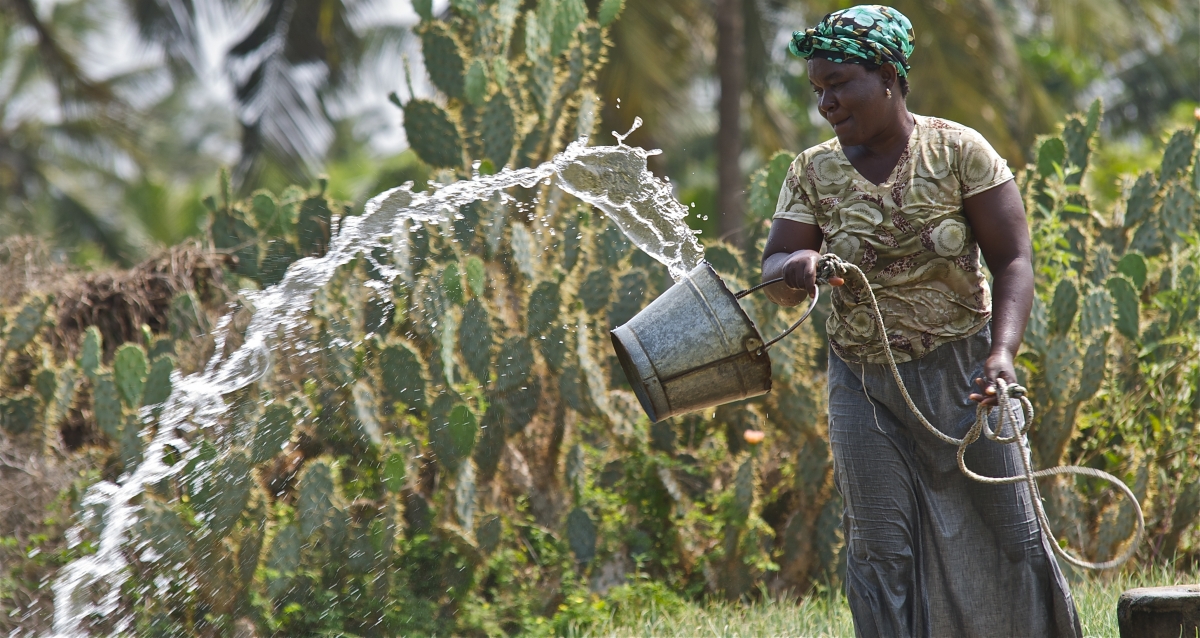
In each of March and April’s Innovation Lab for Small Scale Irrigation workshops in Ethiopia, Ghana, and Tanzania—all of which focused on promoting gender equality in irrigation—workshop discussions pointed to a similar concern: women are frequently excluded from community-level decision making on water allocations for irrigation. Participants pointed out how women do not have opportunities to join institutions that set and enforce these rules. In each workshop, participants asked, what can we do to strengthen women’s meaningful participation in water governance?
This is an important question, but solutions may require that we reframe the question. For this quarterly Science on the Pulse post focused on gender, we draw on recent literature from women’s participation in natural resource governance institutions to examine three common assumptions about women’s participation in community-level water governance.
1.Women will not have influence until they can overcome constraints to participate in decision making institutions.
Women’s limited participation in community decision-making groups reflects underlying gender constraints in the social fabric (Coleman and Mwangi 2013), which are well documented:
- Social norms discourage women from speaking in public based on social perceptions of women’s abilities as unknowledgeable or illiterate (Agarwal 2001)
- Some membership criteria implicitly discriminate against women by requiring land title, fees for participation, or that group members be the head of household; if only one member of the household is allowed to attend, the representative is more likely to be a man (Coleman and Mwangi 2013)
Such constraints produce higher costs, as well as risks, for women’s participation:
- Women’s “double burdens and triple roles” as farmers, caretakers, and cash earners (Tanwir and Safdar 2013) limit the amount of time and time of day they have available for participating in additional activities, especially if travel is required (Lebel et al. 2015); safety concerns and social norms further inhibit mobility(Das 2014).
But even if the playing field was leveled, would women actually want to participate in community resource-management groups? Meinzen-Dick and Zwarteveen (1998) point out:
- Women have other mechanisms of influence that can be effective for getting their needs represented. For example, in Ethiopia, Yami (2013) reports that some women, rather than participating by themselves, prefer to ask their husbands or male relatives to discuss problems in water user association meetings.
- If women don’t claim formal rights, they may actually face less resistance to get access to water, even if they are not following local rules.
Though these informal channels of influence may allow women to achieve access, they are less secure since they do not grant formal control or decision-making power over water. However, examining women’s involvement in informal channels of influence could give rise to alternative decision-making structures, like nested governance models where women-only groups discuss their priorities before conveying them to the village council or water user association.
2.If the group’s quota for women is met, women’s needs will be represented.
Increasingly quotas for women’s participation are being established to promote women’s participation in local governance institutions. However, though quotas provide an entry point for women to engage in formal political processes, quota-filling alone does not ensure women’s influence:
- In Northern India, quotas increased women’s likelihood of attending formal meetings but not speaking publicly at these meetings(Girard 2014).
- Other evidence that counters this assumption is widely available: see also Prokopy’s discussion of tokenism (2004) and Dewan, Buisson and Mukherji’s record of women members’ informal exclusion in meetings (2014).
Public speaking trainings and other capacity-strengthening activities are an important supplement to group membership quotas, but only a piece of the puzzle: capacity strengthening that only targets women misses an opportunity to sensitize men to the benefits of listening to women’s contributions. In addition to individual skills-building, collective solidarity can increase agency and bargaining power of women (Das 2014).
3.Women’s participation in community resource management institutions will lead to better outcomes for all
This assertion is often used to justify efforts to increase women’s participation in decision making institutions. There is promising evidence for the validity of this assumption, in some contexts:
- In a study of 46 natural resource management groups, Westermann et al (2005) found that collaboration, solidarity, and conflict resolution all increased with women’s presence in groups, and that norms of reciprocity were higher in women’s and mixed groups, which they suggest may stem from women’s work responsibilities which rely on frequent cooperation.
- Coleman and Mwangi (2013) find that women’s participation in meetings is likely to reduce disruptive conflict.
- Agarwal (2009) found positive effects of women’s participation in forest governance institutions on forest protection and rule compliance.
Yet Mwangi, Meinzen-Dick, and Sun (2011) point out that relying on women as the panacea to decision-making woes ignores the constraints in social life that women also face within groups that restrict their efficacy, such as time constraints, relative limitations in access to information, and power to sanction and enforce rules.
The authors recognize that mixed groups of men and women are more effective because they draw on the relative strengths of both genders. However, especially in highly segregated communities, the transaction costs of organizing a mixed group are higher (Pandolfelli, Meinzen-Dick, & Dorn 2008), in which case incremental approaches to organizing collective voice, with single-sex groups, may be preferable.
These studies and others listed below point out that formal groups have the potential to support women’s agency in decision-making, but provide caveats about how to achieve this, and what outcomes to expect from women’s participation. Certainly, social views of women, individual women’s skills, and collective women’s solidarity affect women’s influence in decision-making, and are important contextual factors for implementing quotas effectively. These studies help clarify further research needed for project managers to design better interventions that support women’s right to participate in decisions over issues that concern them, like documenting the efficacy of women’s different channels to influence decisions, understanding supply and demand-side capacity strengthening approaches to support women’s participation, and identifying mechanisms by which women’s participation affects outcomes like resource sustainability, perceptions of fairness, attention to women’s priorities, and conflict resolution.
Works Cited and Bibliography:
- Agarwal (2001) Participatory exclusions, community forestry, and gender: an analysis for South Asia and a conceptual framework
- Agarwal (2009) Gender and forest conservation: the impact of women’s participation in community forest governance
- Coleman and Mwangi (2013) Women's participation in forest management: A cross-country analysis
- Das (2014) Women’s participation in community-level water governance in urban India: the gap between motivation and ability
- Dewan, Buisson, and Mukherji (2014) The imposition of participation? The case of participatory water management in coastal Bangladesh.
- Girard (2014) Stepping into formal politics: women’s engagement in formal political processes in irrigation in rural India
- Lebel, Lebel, Sriyasak, Ratanawilailak, Bastakoti, Bastakoti (2015) Gender relations and water management in different eco-cultural contexts in northern Thailand
- Mwangi, Meinzen-Dick, and Sun (2011) Gender and sustainable forest management in East Africa and Latin America
- Prokopy (2004) Women’s participation in rural water supply projects in India: is it moving beyond tokenism and does it matter?
- Yami (2013) Sustaining participation in irrigation systems of Ethiopia: what have we learned about water user associations?
- Singh (2008) Equitable gender participation in local water governance: an insight into institutional paradoxes
- Tanwir and Safdar (2013) Rural women’s constraints to participation in rural organizations
- Westermann, Ashby, Pretty (2005) Gender and social capital: the Importance of gender differences for the maturity and effectiveness of natural resource management groups




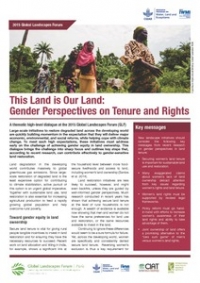
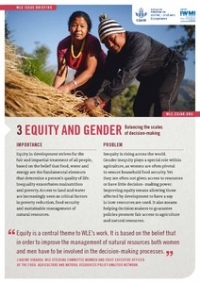
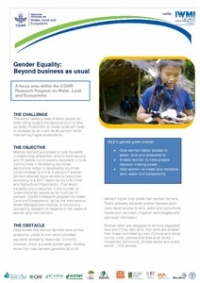
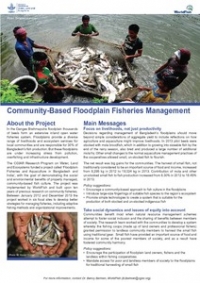
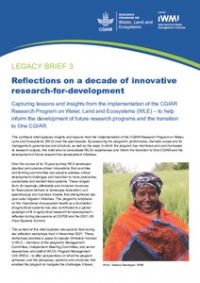
Comments
The likelihood of success & long lasting impact for such interventions rests on innovative methods for productive mixed groups (men and women) discussions, once specific issues are diagnosed using separate discussions with men and women groups.